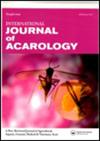薄荷植物化学物质和次生代谢物在抑制荨麻疹叶螨乙酰胆碱酯酶中的作用
IF 1
3区 农林科学
Q3 ENTOMOLOGY
引用次数: 0
摘要
摘要荨麻疹叶螨(Tetranychus urticae Koch)对全球粮食生产构成严重威胁。然而,与合成农药相关的环境风险使探索环保替代品成为必要。利用次生代谢物的植物性生物农药已成为害虫管理的有前途的策略。本研究旨在通过生化分析、GC-MS、LC-QTOF-MS等方法对薄荷进行提取和表征。该提取物对荨麻疹叶螨的杀螨、阻卵和驱避性能进行了评估,在96小时内显示出明显的时间和浓度依赖性,LC50为3µg/mL。此外,利用番茄植株评估了提取物对植物生长的影响,基于光合作用、重量和氧化应激标记分析,证明了生长速度的提高。其中多酚类物质和萜类物质被认为是其抗氧化和清除自由基等生物活性的重要成分。对鉴定的植物化合物进行了靶向乙酰胆碱酯酶(AChE)的分子对接实验,表明它们对δ-3- cararene和isofeuloyl C1 glucuronide具有高亲和力。这些化合物的杀虫作用归因于它们对乙酰胆碱酯的竞争性和协同抑制作用。这些发现强调了植物提取物,特别是细刺草提取物在未来害虫防治策略中作为有效生物农药的潜力。利用植物次生代谢物为防治荨麻疹提供了一种可持续和环保的方法。关键词:双点蜘蛛、杀螨剂、生物农药、植物替代品、可持续害虫防治、分子连接、生态友好型替代品。作者感谢Ege - matal (Ege University, Izmir, Turkey)的基础设施,他们帮助进行了GC-MS和LC-QTOF-MS分析。披露声明作者未报告潜在的利益冲突。数据可用性声明数据作为本手稿的补充材料提供。如有合理要求,可向通讯作者索取其他原始资料。作者声明:概念、方法、调查。LG:概念、方法、资源、调查。HM:概念化,方法论,验证,形式分析,写作-原稿,写作-审查和编辑,可视化。形式分析,调查,写作-原稿,可视化。YK:形式分析,调查,写作-原稿,可视化。LYA:概念化,方法论,验证,资源,写作-审查和编辑,监督。FZ:概念,方法,验证,资源,写作-审查和编辑,监督,项目管理。补充材料本文的补充数据可在https://doi.org/10.1080/01647954.2023.2275754Additional上在线获取。本文章由计算机程序翻译,如有差异,请以英文原文为准。
Role of phytochemicals and secondary metabolites from Mentha spicata in acetylcholine esterase inhibition for effective pest control of Tetranychus urticae Koch
ABSTRACTThe two-spotted spider mite (Tetranychus urticae Koch) poses a significant threat to global food production. However, the environmental risks associated with synthetic pesticides have necessitated the exploration of eco-friendly alternatives. Plant-based biopesticides utilizing secondary metabolites have emerged as promising strategies for pest management. This study aimed to extract and characterize Mentha spicata L. through biochemical analyses, GC-MS, and LC-QTOF-MS. The extract’s acaricidal, oviposition deterrence, and repellent properties were evaluated against Tetranychus urticae, revealing a pronounced time- and concentration-dependent effect over 96 hours, with an LC50 of 3 µg/mL. Furthermore, the impact of the extract on plant growth was assessed using tomato plants, demonstrating an enhancement in growth rate based on photosynthesis, weight, and oxidative stress markers analyses. Polyphenolics and terpenoids in M. spicata were identified as contributors to its biological activities, including antioxidant and free-radical scavenging properties. Molecular docking experiments targeting acetylcholine esterase (AChE) were conducted on the identified phytocompounds, indicating a high affinity for δ-3-Carene and Isoferuloyl C1 glucuronide. The pesticidal effects of these compounds were attributed to their competitive and synergistic inhibition of AChE. These findings highlight the potential of plant extracts, specifically M. spicata, as effective biopesticides in future pest control strategies. The utilization of secondary metabolites from plant sources offers a sustainable and environmentally friendly approach to combatting T. urticae infestations.KEYWORDS: Two-spotted spider miteacaricidalbiopesticideplant-based alternativessustainable pest controlMolecular dockingeco-friendly alternatives AcknowledgmentsThe authors thank the infrastructure of EGE-MATAL (Ege University, Izmir, Turkey) for their help in performing the GC-MS and LC-QTOF-MS analysis.Disclosure statementNo potential conflict of interest was reported by the author(s).Data availability statementData are made available as supplementary material attached to this manuscript. Other raw data can be obtained from the corresponding author under reasonable request.CRedIT author statementTM: Conceptualization, Methodology, Investigation. LG: Conceptualization, Methodology, Resources, Investigation. HM: Conceptualization, Methodology, Validation, Formal analysis, Writing – Original Draft, Writing – Review & Editing, Visualization. KT: Formal analysis, Investigation, Writing – Original Draft, Visualization. YK: Formal analysis, Investigation, Writing – Original Draft, Visualization. LYA: Conceptualization, Methodology, Validation, Resources, Writing – Review & Editing, Supervision. FZ: Conceptualization, Methodology, Validation, Resources, Writing – Review & Editing, Supervision, Project administration.Supplementary materialSupplemental data for this article can be accessed online at https://doi.org/10.1080/01647954.2023.2275754Additional informationFundingThe study did not receive any specific funding.
求助全文
通过发布文献求助,成功后即可免费获取论文全文。
去求助
来源期刊
CiteScore
2.20
自引率
9.10%
发文量
60
审稿时长
6-12 weeks
期刊介绍:
The International Journal of Acarology has a global readership and publishes original research and review papers on a wide variety of acarological subjects including:
• mite and tick behavior
• biochemistry
• biology
• control
• ecology
• evolution
• morphology
• physiology
• systematics
• taxonomy (single species descriptions are discouraged unless accompanied by additional new information on ecology, biology, systematics, etc.)
All submitted manuscripts are subject to initial appraisal by the Editor. If the English is not of a quality suitable for reviewers, the manuscript will be returned. If found suitable for further consideration, it will be submitted to peer review by independent, anonymous expert referees. All peer review is single blind.

 求助内容:
求助内容: 应助结果提醒方式:
应助结果提醒方式:


